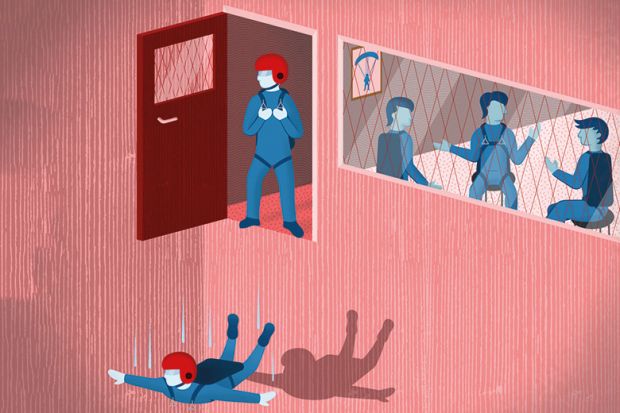It did not take long this academic year for the first row over free expression and diversity to make headlines. Balliol College, Oxford, found itself in the spotlight after its Junior Common Room banned its Christian Union from participating in a freshers’ fair. The union’s presence, apparently, would constitute a “micro-aggression” because of the history and practices of certain Christian sects. Observers immediately called the decision an attack on both free expression and freedom of religion.
The debate is all too familiar. Do we tolerate speech on our campuses with which we vehemently disagree? Are we coddling the young? Are our students “snowflakes”, whose demand for “safe spaces” signals the end to free expression and academic freedom?
Even novelist Ian McEwan (whose work I love and read without exception) has got in on the act. In his most recent novel, Nutshell, he writes: “A strange mood has seized the almost-educated young. They’re on the march, angry at times, but mostly needful, longing for authority’s blessing, its validation of their chosen identities…Should inconvenient opinions hover near me like fallen angels or evil djinn (a mile being too near), I’ll be in need of the special campus safe room equipped with Play-Doh and looped footage of gambolling puppies. Ah, the intellectual life!”
I disagree with those who would reduce our students to caricatures of themselves. The creation of “safe spaces” is not the end of academic discourse. No student I’ve ever met is asking for gambolling puppies, and they make the good point that, historically, educational institutions have not been welcoming to all. We are doing better at diversity, equity and inclusion today, but there is still a long way to go.
But pitting legitimate diversity efforts against principles of free expression – and, in the case of Balliol, the free exercise of religion – will only set our communities back.
As educators, we ought to create both safe spaces and brave spaces. By safe spaces, I do not mean the toy- and cushion-filled rooms decried in the media. I mean environments in which students can explore ideas and express themselves in a conversation with well-understood ground rules. For instance, a university might create a safe space – a literal room, or a periodic, itinerant session, often moderated by an adult or peer skilled in understanding the relevant issues – in which LGBTQ students can discuss issues of sexual identity or gender without being made to feel marginalised. Ideally, such a space would help students find support, develop coping skills and hone effective techniques for communicating with one another in a way that avoids stereotypes and honours tolerance.
But our campuses need brave spaces, too, like they need oxygen. By brave spaces, I mean learning environments that approximate the world beyond the academy. These include classrooms, lecture halls and public forums, in which the rules and norms for expression – set by the university and made plain to students – should permit a free exchange of views even when that is uncomfortable for certain students.
Brave spaces are learning environments in which the primary purpose of the interaction is a search for the truth, rather than support for a particular group of students. They are free of violence and heckling, but not of ideological conflict – and students at most institutions will spend most of their time in them.
A freshers’ fair should be a brave space, in my book, in which students arriving in an academic community are presented with a range of ways to participate and connect with others. Can certain groups be excluded? Surely the answer is yes: a neo-Nazi group might reasonably be banned in the name of diversity, equity and inclusion. Can student groups protest the presence of a Christian group whose opposition to same-sex unions is abhorrent to the university’s values of inclusion? Absolutely.
But excluding the Christian Union is impossible to justify. This is where the critics of modern students have much the better argument: the Balliol JCR fails to make a legitimate point about inclusion when it does so by excluding a broad-based faith group. And, by my lights, the Christian Union was right to turn down the subsequent offer to place leaflets on a table without any representatives present.
There is no doubt that certain Christian religions and groups have much to account for regarding both their past behaviour and, in too many cases, their present policies. I believe in the existence of micro-aggressions, and in the harms they can cause. But to say that the very presence of the Christian Union at a student fair is a micro-aggression is to extend an argument well beyond its breaking point. Among many other concerns, students of faith are frequently the students who feel the most excluded on our predominantly secular campuses. Just as importantly, we do our students no good by protecting them from any point of view with which they might reasonably disagree.
We must ground our approach to disputes over free expression and diversity in our institutions’ core values and educational goals – and we must communicate that connection with force and clarity, through our teaching and our public statements.
Students and administrators alike should resist pitting diversity against free expression. Rather, we should seek to find where they intersect to the fullest degree. Only this way will we produce the kinds of well-rounded citizens able to thrive in a democracy.
John Palfrey is head of school at Phillips Academy, a university preparatory school in Andover, Massachusetts. He was previously professor and vice-dean at Harvard Law School. His latest book, Safe Spaces, Brave Spaces, is published this month by MIT Press.
后记
Print headline: We need a brave space




